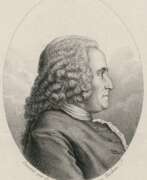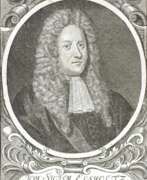Botanists 17th century


Filippo Bonanni or Buonanni was an Italian Jesuit scholar. His many works included treatises on fields ranging from anatomy to music. He created the earliest practical illustrated guide for shell collectors in 1681, for which he is considered a founder of conchology. He also published a study of lacquer that has been of lasting value since his death.


Caspar Commelin was a Dutch botanist and mycologist.
Caspar Commelin was trained as a medical doctor, practiced botanical science and worked on books that were left unfinished due to the death of his uncle, botanist Jan Commelin. Caspar was mainly interested in exotic plants.


Jan Commelin (Dutch: Jan Commelin or Jan Commelijn), also Johannes Commelin, was a Dutch botanist.
Jan Commelin is the son of the historian Isaac Commelin. He was a professor of botany and director of the Amsterdam Botanical Gardens. Jan Commelin wrote many scientific works on botany, notably compiling the first volume of descriptions of East and West Indian plants. The second volume was written by Jan's nephew, the botanist Caspar Kommelin, who expanded the earlier descriptions and added notes on African plants.


Denis Dodart was a French botanist, naturalist and physician.
Dodart studied at the University of Paris, received a doctorate in medicine and was already in his youth known for his erudition, eloquence and open-mindedness. In 1673 he was elected to the French Academy of Sciences.
He is known for his early studies of plant respiration and growth. Dodart collaborated with the French engraver Nicolas Robert to illustrate his botanical works.


Johann Sigismund Elsholtz (also Elßholtz, Elßholz, Elsholz, Latin Elsholtius) was a German physician, botanist and chemist, a pioneer of hygiene.
Elsholtz studied at the universities of Wittenberg, Königsberg, and Padua, where he received his doctorate. In 1654, he published Anthropometry, written for artists and astrologers as well as students of medicine and physiognomy. The book also explored the supposed relationship between the proportions of the human body and morbidity. Elsholtz was a very versatile scientist and worked in the fields of horticulture, botany, alchemy, astrology, dietetics and medicine, among others.
Elsholtz was later appointed court botanist, alchemist and physician to Elector Friedrich Wilhelm of Brandenburg (1620-1688), and in 1657 was placed in charge of his botanical gardens in Berlin, Potsdam and Oranienburg. In 1672 his treatise Vom Garten-Baw: Oder Unterricht von der Gärtnerey auff das Clima der Chur-Marck Brandenburg was published in Berlin. ("From the Garden Bow or Lessons in Gardening in the Climate of Chur-Marck Brandenburg." It presents the latest gardening techniques for the German climate, discussing flower gardens and their design, vegetable gardens, medicinal gardens, and vineyard care and design.
Elsholtz was a German pioneer in the field of cleanliness and nutrition. Generally speaking, the term "hygiene" first appeared in German in 1682 in his Dietetikon. It is the term he uses to describe the principle of maintaining good health. In his book, the doctor makes recommendations for healthy eating and drinking. He calls for clean water and good air and emphasizes the importance of personal hygiene. Elsholtz was one of the first to administer intravenous injections to people around 1665.


Giovanni Battista Ferrari was an Italian Jesuit scholar, professor of Oriental languages and botanist.
Giovanni Ferrari had linguistic abilities and at the age of 21 knew Hebrew well, spoke and wrote Greek and Latin perfectly, and learned Syriac. He became professor of Hebrew and rhetoric at the Jesuit College in Rome and edited a Syriac-Latin dictionary in 1622.
Ferrari always showed great interest in the systematics and classification of fruits. He was appointed head of the chair of Hebraistics at the College of Rome and held this position for 28 years. In 1623, Ferrari became horticultural advisor to the family of Pope Urban VIII at the Palazzo Barberini, which soon became famous for its rare plants, including orange trees. Ferrari later wrote the first book on citrus trees, equating them to the mythical golden apples of the Hesperides conquered by Hercules. Orange trees became an important element of Baroque gardens, symbolizing the rewards earned by the magnanimous prince. The scientist also described the medicinal properties of citrus fruits.
In 1633, the first treatise on floriculture, De florum cultura, was published. In it, Ferrari describes garden layout with contemporary examples, flower specimens and their cultivation, and general horticulture.


William Howe or How was a British botanist and physician.
He studied at St. John's College, Oxford, earning a bachelor's degree and then a master's degree in medicine. He served briefly in the King's army as a cavalry commander, and later returned to the medical profession and practiced in London.
In his Phytologia Britannica, natales exhibens Indigenarum stirpium sponte Emergentium ("Phytology Britannica"), published in London in 1650, William Howe combined Thomas Johnson's catalogs into a single alphabetical list, supplemented with additional plants from other sources. This was the first edition of the book to compile for the first time all the known plants of Britain with descriptions of their occurrence.


John Ray was a British clergyman, naturalist, botanist and zoologist, and a Fellow of the Royal Society of London.
He came from a poor family, but through his persistence in acquiring knowledge he achieved recognition as a scientist. Ray published important works on botany, zoology, and natural history. His classification of plants in Historia Plantarum was an important step toward modern taxonomy (the scientific study of naming, defining, and classifying groups of biological organisms based on common characteristics). John Ray was the first to provide a biological definition of the term "species."


Antonio Vallisneri the Elder was an Italian naturalist, physician and geologist, collector, and member of the Royal Society of London.
He studied in Bologna, Venice, Padua and Parma and headed the chair first of practical medicine and then of theoretical medicine at the University of Padua. In addition to medicine, Vallisneri conducted important research in the natural sciences. In particular, in the field of geology, he is credited with recognizing the organic nature of fossils unrelated to the Great Flood, which contributed to the end of centuries-old disputes. His observations on the water cycle, thermal waters and some mines in the Apennines were also important.
Vallisneri was interested in all branches of the natural sciences, collecting numerous collections of animals, minerals, and other natural objects during his lifetime. The scientist compiled a brief catalog of his collection, which was published in 1733 by his son, Antonio Vallisneri, Jr. The Vallisneri Museum included naturalistic finds, anatomical preparations, medical and scientific instruments, antiques, and exotics from various cultures and eras as well as geographical origins. In 1734, his son donated this museum to the University of Padua, initiating the creation of a general museum for the university.
Antonio Vallisneri Jr. followed in his father's footsteps and for many years held the position of professor of natural history at the University of Padua. He devoted his life to collecting and processing his father's writings and tidying up his library, which contained about a thousand volumes. These were donated to the University Library in Padua.


Adriaan van den Spiegel (or Spieghel), name sometimes written as Adrianus Spigelius, was a Flemish anatomist born in Brussels. For much of his career he practiced medicine in Padua, and is considered one of the great physicians associated with the city. At Padua he studied anatomy under Girolamo Fabrici.
His best written work on anatomy is De humani corporis fabrica libri X tabulis aere icisis exornati, published posthumously in 1627. In his 1624 treatise De semitertiana libri quatuor, he gave the first comprehensive description of malaria.


Frans van Sterbeeck or Johannes Franciscus van Sterbeeck was a Flemish clergyman, botanist and mycologist, painter, architect and historian.
In addition to his work as a priest, van Sterbeeck had a passion for botany and corresponded with prominent botanists of his time, including John Ray. In particular, he made a serious study of fungi and as a result produced a work entitled Theatrum fungorum oft het tooneel der Campernoelien, published in Antwerp in 1675. This richly illustrated book in Dutch describes the edible and poisonous species of mushrooms.
Frans van Sterbeeck also designed the main altar of the Antwerp Preaching Church and the portal of the Beguinage Church in 1680, and wrote two works on historical subjects.









